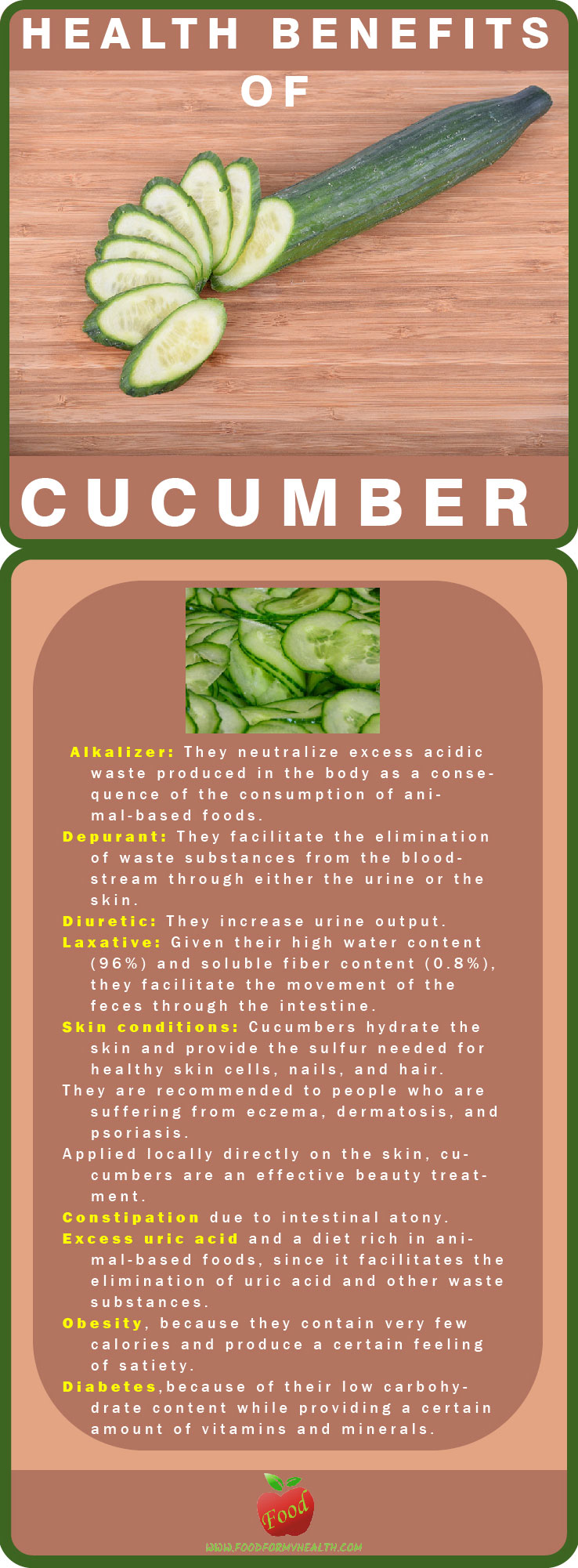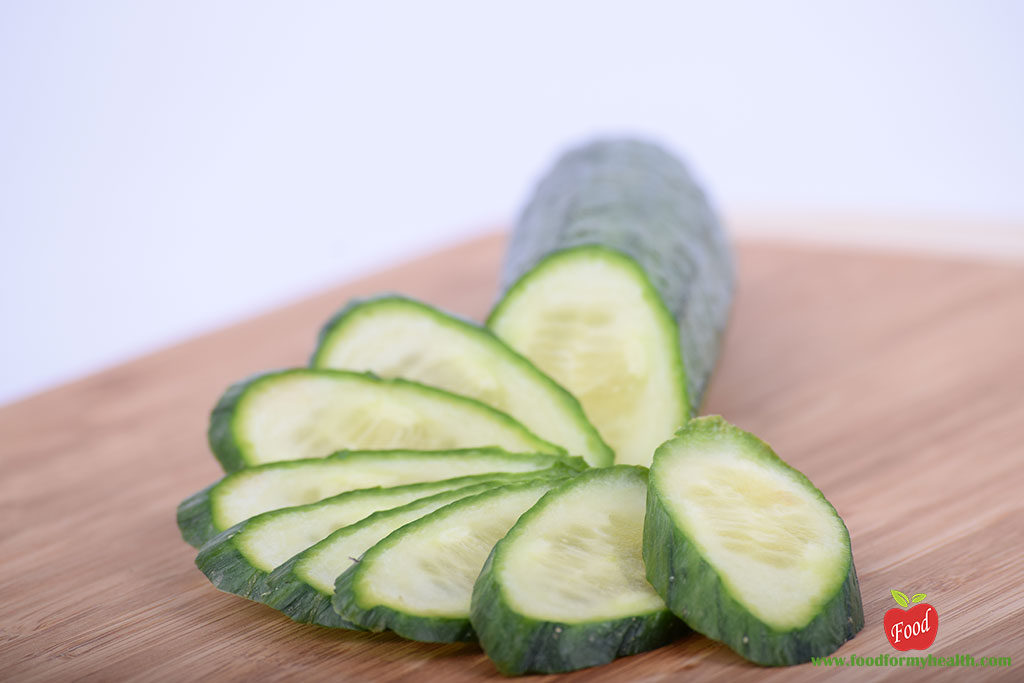Cucumber
Cucumber is a plant of the `Cucumis sativus`, an herbaceous vine of the botanical family Cucurbitaceae that reaches approximately one meter in height. Cucumbers are eaten unripe since ripe specimens lose their crispness and become spongy and yellow. They measure from 15 to 25 cm in length and about 5 cm in diameter. They are grown throughout the world both in a fresh air and in greenhouses. Because of their high water content, the cucumbers are among the lowest calorie vegetables. However, this does not impede it from being the fourth most cultivated vegetable in the world, behind tomatoes, cabbage, and onions. China and Russia are the main producing countries. The cucumber is native to the south of Asia, although it spread rapidly throughout the ancient world. The Egyptians, the Greeks, and the Romans knew and enjoyed them. The cucumber is native to the south of Asia, although it spread rapidly throughout the ancient world The Egyptians, the Greeks, and the Romans knew and enjoyed them.

Cucumber nutrition facts and health benefits
The health and beauty of the skin depend more on the purity of the blood than on the topical application of cosmetic products. True beauty comes from the inside.
Eating a cucumber is like drinking a glass of water. Bearing in mind that 96% of its weight is water; a 250g cucumber contains 240 g of water. However, this does not mean that it is of little nutritional value. Those 10 grams of solid material in a 250g cucumber have great biological value and healing power. Cucumbers are among the most water-rich foods, and as a result only contain 13 kcal/ 100 g. Their protein (0.69%), carbohydrate (1.96%), and fat (0.13%) content is very low. They also contain small amounts of provitamin A, and vitamins B, C, and E. Their high dietary and therapeutic value resides in their minerals, which are highly alkaline. They contain potassium, calcium, phosphorus, magnesium, and iron, as well as various trace elements, most notably sulfur.
Cucumbers have the following medicinal properties:
- Alkalizer: They neutralize excess acidic waste produced in the body as a consequence of the consumption of animal-based foods.
- Depurant: They facilitate the elimination of waste substances from the bloodstream through either the urine or the skin.
- Diuretic: They increase urine output.
- Laxative: Given their high water content (96%) and soluble fiber content (0.8%), they facilitate the movement of the feces through the intestine.
These are cucumbers’ primary applications:
- Skin conditions: Cucumbers hydrate the skin and provide the sulfur needed for healthy skin cells, nails, and At the same time, they “cleanse” the bloodstream of toxic wastes. They are recommended to people who are suffering from eczema, dermatosis, and psoriasis. Applied locally directly on the skin, cucumbers are an effective beauty treatment.
The best results are obtained by combining cucumbers’ internal properties and their external effect on the skin. This is done by:
- Rubbing it directly to the skin.
- Preparing thin slices and placing them on affected skin areas.
- Constipation due to intestinal atony.
- Excess uric acid and a diet rich in animal-based foods, since it facilitates the elimination of uric acid and other waste substances.
- Obesity, because they contain very few calories and produce a certain feeling of satiety.
- Diabetes, because of their low carbohydrate content while providing a certain amount of vitamins and minerals.
Preparation and Use
Raw: Cucumbers are usually eaten this way since they are harvested unripe, they must be well chewed to prevent indigestion. They may be eaten in a salad with oil and lemon or blended with tomato and other vegetables. They should be peeled to avoid pesticide residue if they have not been organically grown.
Cooked: They may be baked with cheese, used in soups, or cooked with other vegetables.
Pickled: A particular type of smaller cucumber is prepared in salt and vinegar to preserve them. Because of these two products, pickles are rather unhealthy.
Caution: Cucumbers are somewhat indigestible and may not be well tolerated by those suffering from dyspepsia or that have a frail stomach. The fact that they are usually eaten green contributes to this problem. To improve tolerance they should be well chewed, and specimens that are too green and bitter should be avoided. They should always be peeled.

Energy and nutrition value
Energy and nutrition value are for 100 g.
| Nutrient | Unit | Value per 100 g |
|---|---|---|
| Water | g | 95.23 |
| Energy | kcal | 15 |
| Protein | g | 0.65 |
| Total lipid (fat) | g | 0,11 |
| Carbohydrate, by difference | g | 3.63 |
| Fiber, total dietary | g | 0.5 |
| Sugars, total | g | 1.67 |
| Calcium, Ca | mg | 16 |
| Iron, Fe | mg | 0,28 |
| Magnesium, Mg | mg | 13 |
| Phosphorus, P | mg | 24 |
| Potassium, K | mg | 147 |
| Sodium, Na | mg | 2 |
| Zinc, Zn | mg | 0.20 |
| Vitamin C, total ascorbic acid | mg | 2.8 |
| Thiamin | mg | 0,027 |
| Riboflavin | mg | 0,033 |
| Niacin | mg | 0,098 |
| Vitamin B-6 | mg | 0,040 |
| Folate, DFE | µg | 7 |
| Vitamin B-12 | µg | 0,00 |
| Vitamin A, RAE | µg | 5 |
| Vitamin A, IU | IU | 105 |
| Vitamin E (alpha-tocopherol) | µg | 0.03 |
| Vitamin D (D2 + D3) | mg | 0,00 |
| Vitamin D | IU | 0 |
| Vitamin K (phylloquinone) | µg | 16.4 |
| Fatty acids, total saturated | g | 0,037 |
| Fatty acids, total monounsaturated | g | 0,05 |
| Fatty acids, total polyunsaturated | g | 0,032 |
| Fatty acids, total trans | g | 0,000 |
| Cholesterol | 0 | 0,000 |
| Caffeine | 0 | 0,000 |
*Source National Nutrient Database for Standard Reference Release 28
Related: Cucumber Lemonade With Chia Seeds


